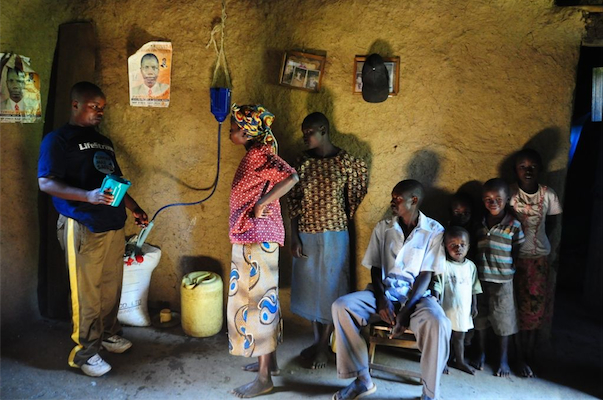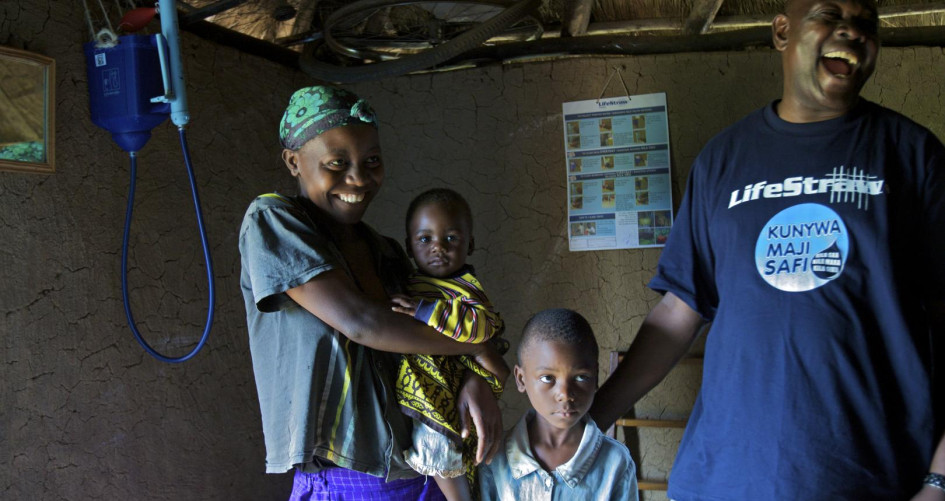Focus area: Mitigation
Website
Location: Kenya's Western Province
Activity established: April 2011
Version en espanol
Infographic
Access to clean drinking water is a problem in many parts of Africa, and its purification is a problem for the environment. Dirty water often must be boiled to purify it, requiring fuel from unsustainable and costly sources, like wood or kerosene. In 2011, Vestergaard Frandsen launched a breakthrough initiative called LifeStraw® Carbon For Water™.
LifeStraw® Carbon For Water™ is an easy to set up and maintain water purification system that uses no fuel. Each filter can produce at least 18,000 liters of -quality drinking water over a 10-year life span. The Kenyans who received the family filter no longer need to treat water by boiling it using wood fuel - a traditional necessity that releases greenhouse gasses.
It uses carbon financing to sustainably provide 4.5 million people in Kenya with the ability to treat water in their homes for the next ten years.
It doesn't cost the government or aid donors anything, and is designed to be replicated in other appropriate settings. Close to 880,000 LifeStraw® Family water filters were delivered to 91 percent of all households without access to safe municipal water in Kenya's Western Province.
The innovative Carbon For Water financing model can make a significant contribution to global health by demonstrating that novel approaches can overcome traditional financial limitations.
Additionally, the activity links profit intrinsically to performance, a relatively new concept in the aid and public health sectors.
LifeStraw® Carbon For Water is also unique as the first activity to directly link carbon credits with safe drinking water.
It moves beyond a pure focus on CO2 reductions to include measured sustainable development. It also emphasizes emission reductions that go beyond single point sources.
LifeStraw® Carbon For Water makes an important correction to the imbalance that exists in the global carbon market. While Africa is considered among the most at-risk areas for climate change, it has historically been on the margins of the climate markets, with less than five per cent of carbon projects having been implemented there.
Mitigation / Adaptation
As a self-financing activity, LifeStraw® Carbon For Water is measured based on its ability to reduce or avoid greenhouse gas emissions. Emission reductions result in carbon credits, each created when the equivalent of one metric ton of carbon dioxide is prevented from entering the atmosphere. Credits have a monetary value depending on the type and origin of the emission reductions produced and current prices in the carbon market.
After the first six months, almost 1.4 million tons of carbon emission reductions were realized. Annually, the activity is expected to reduce an estimated 2.7 million tons of carbon emissions.
The LifeStraw® Carbon For Water activity provides a number of interesting opportunities for operational research, sustainability research, economics or cost efficiency research, and health impact research. Health impact research is already underway and Vestergaard Frandsen is meeting with world class researchers to design and develop further studies to measure various impacts.

Social and environmental benefits
LifeStraw® Carbon For Water is reducing the incidence of waterborne diseases. Preliminary results show a statistically significant reduction in the odds of diarrhea, dysentery and severe dehydration among under-fives whose households are exclusively using LifeStraw® Family water filters.
LifeStraw® Carbon For Water can also reduce the incidence of respiratory illnesses. Pollution from heating with biomass fuels such as wood increases susceptibility to pneumonia, especially among children.
LifeStraw® Carbon For Water helps to empower local residents by giving them an easy way to produce safe drinking water. It also employs thousands of Kenyans in its semi-annual campaigns to distribute the water filters and train recipients on usage. And Vestergaard Frandsen employs scores to work at 32 repair and replacement centers throughout the province and as district coordinators and supervisors (on an ongoing basis). Forty-five coordinators and more than 150 community volunteers are engaged full-time.
The major socio-economic contribution of the LifeStraw® Carbon For Water activity is its ability to offer a sustainable, self-financed solution to problems that arise when individuals and communities don't have access to safe drinking water - namely interruptions in education and income-bearing activities due to illness and the collection of fuel for boiling water. This is a breakthrough, especially with regard to point-of-use water treatments.
Community members have been involved in the planning and their feedback is constantly solicited. Also, to mitigate against the potential risk of under-use, Vestergaard Frandsen conducts ongoing community education to remind residents about the importance of continually using the water filters for optimal water consumption.
On a global level, LifeStraw® Carbon For Water can make a significant contribution to global health by demonstrating that novel approaches to overcoming traditional financial limitations can be sustained. Sustainable programs must be instituted to ensure that people have ongoing access to vital public health interventions that can improve and often save lives.
Potential for scaling-up and replication
The current iteration of LifeStraw® Carbon For Water will sustain itself, eventually recouping the US$30 million investment, and then generating profit, much of which will be reinvested back into the activity over the next decade.
LifeStraw® Carbon For Water is a scalable model that can be extended or replicated in different settings.
Larger iterations of the concept, currently in the planning phases, will require co-investment from partners. Vestergaard Frandsen is discussing expansion of the concept with governments and private investors in different regions throughout the world.
LifeStraw® Carbon For Water serves as a blueprint for future initiatives to derive income from both market-based emission reductions and results-based health outcomes - thus providing dual income streams and greater activity stability.
This innovative financing model overcomes the challenge of sustaining public health programs with traditional sources of finance, such as aid or grants from public sector or non-governmental groups with limited resources. The financing mechanism also holds public and private sector organizations to greater account, to ensure maximum impact. The activity links profit intrinsically to performance, a relatively new concept in the aid and public health sectors.




Images owned by the activity partners, all rights reserved.

